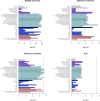Genomics implicates adaptive and innate immunity in Alzheimer's and Parkinson's diseases
- PMID: 28097204
- PMCID: PMC5224821
- DOI: 10.1002/acn3.369
Genomics implicates adaptive and innate immunity in Alzheimer's and Parkinson's diseases
Abstract
Objectives: We assessed the current genetic evidence for the involvement of various cell types and tissue types in the etiology of neurodegenerative diseases, especially in relation to the neuroinflammatory hypothesis of neurodegenerative diseases.
Methods: We obtained large-scale genome-wide association study (GWAS) summary statistics from Parkinson's disease (PD), Alzheimer's disease (AD), and amyotrophic lateral sclerosis (ALS). We used multiple sclerosis (MS), an autoimmune disease of the central nervous system, as a positive control. We applied stratified LD score regression to determine if functional marks for cell type and tissue activity, and gene-set lists were enriched for genetic heritability. We compared our results to those from two gene-set enrichment methods (Ingenuity Pathway Analysis and enrichr).
Results: There were no significant heritability enrichments for annotations marking genes active within brain regions, but there were significant heritability enrichments for annotations marking genes active within cell types that form part of both the innate and adaptive immune systems. We found this for MS (as expected) and also for AD and PD. The strongest signals were from the adaptive immune system (e.g., T cells) for PD, and from both the adaptive (e.g., T cells) and innate (e.g., CD14: a marker for monocytes, and CD15: a marker for neutrophils) immune systems for AD. Annotations from the liver were also significant for AD. Pathway analysis provided complementary results.
Interpretation: For AD and PD, we found significant enrichment of heritability in annotations marking gene activity in immune cells.
Figures


References
Grants and funding
LinkOut - more resources
Full Text Sources
Other Literature Sources
Research Materials
Miscellaneous

